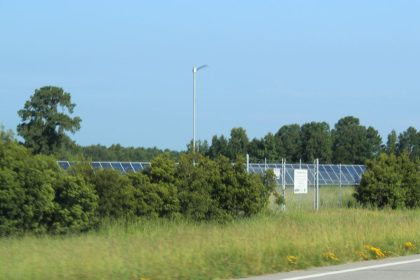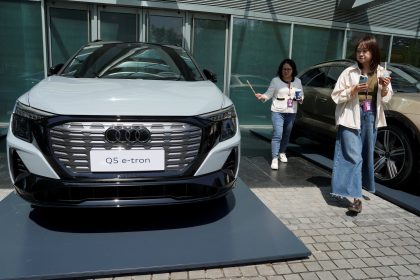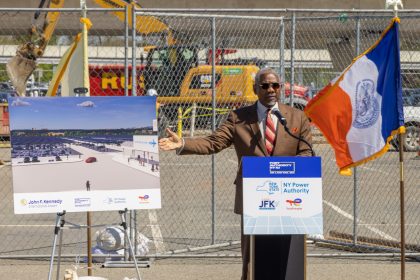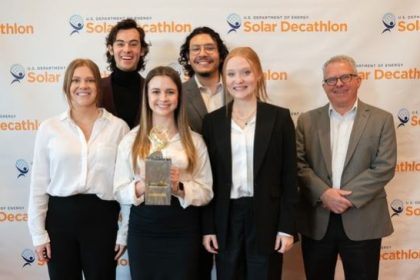Solar Panels on Water Canals Seem Like a No-Brainer. So Why Aren’t They Widespread?
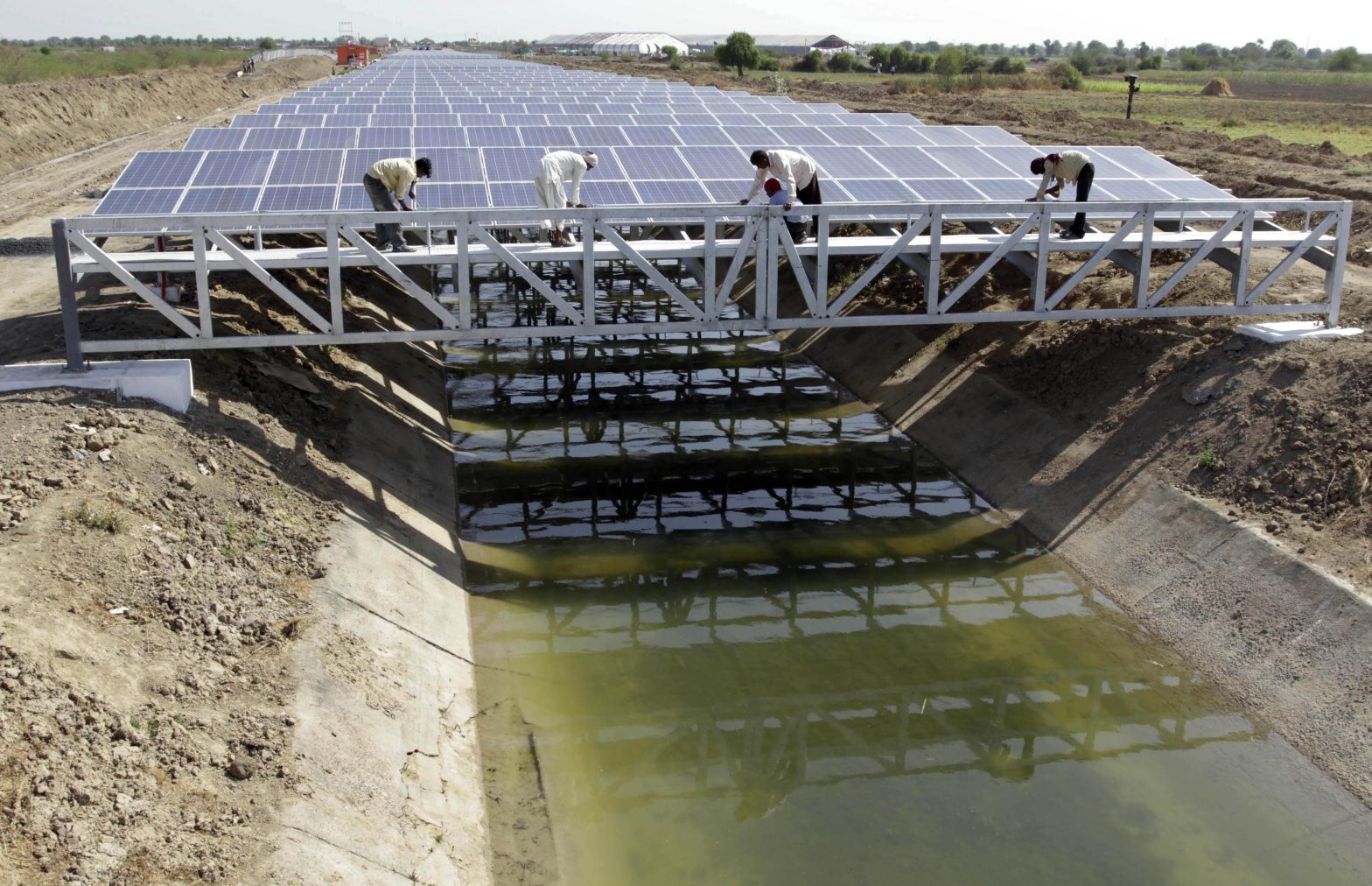
DENVER (AP) — Back in 2015, California’s dry earth was crunching under a fourth year of drought. Then-Governor Jerry Brown ordered an unprecedented 25% reduction in home water use. Farmers, who use the most water, volunteered too to avoid deeper, mandatory cuts.
Brown also set a goal for the state to get half its energy from renewable sources, with climate change bearing down.
Yet when Jordan Harris and Robin Raj went knocking on doors with an idea that addresses both water loss and climate pollution — installing solar panels over irrigation canals — they couldn’t get anyone to commit.
Fast forward eight years. With devastating heat, record-breaking wildfire, looming crisis on the Colorado River, a growing commitment to fighting climate change, and a little bit of movement-building, their company Solar AquaGrid is preparing to break ground on the first solar-covered canal project in the United States.
“All of these coming together at this moment,” Harris said. “Is there a more pressing issue that we could apply our time to?”
The idea is simple: install solar panels over canals in sunny, water-scarce regions where they reduce evaporation and make electricity.
A study by the University of California, Merced gives a boost to the idea, estimating that 63 billion gallons of water could be saved by covering California’s 4,000 miles of canals with solar panels that could also generate 13 gigawatts of power. That’s enough for the entire city of Los Angeles from January through early October.
But that’s an estimate — neither it, nor other potential benefits have been tested scientifically. That’s about to change with Project Nexus in California’s Central Valley.
BUILDING MOMENTUM
Solar on canals has long been discussed as a two-for-one solution in California, where affordable land for energy development is as scarce as water. But the grand idea was still a hypothetical.
Harris, a former record label executive, co-founded “Rock the Vote,” the voter registration push in the early 1990s, and Raj organized socially responsible and sustainability campaigns for businesses. They knew that people needed a nudge – ideally one from a trusted source.
They thought research from a reputable institution might do the trick, and got funding for UC Merced to study the impact of solar-covered-canals in California.
The study’s results have taken off.
They reached Governor Gavin Newsom, who called Wade Crowfoot, his secretary of natural resources.
“Let’s get this in the ground and see what’s possible,” Crowfoot recalled the governor saying.
Around the same time, the Turlock Irrigation District, an entity that also provides power, reached out to UC Merced. It was looking to build a solar project to comply with the state’s increased goal of 100% renewable energy by 2045. But land was very expensive, so building atop existing infrastructure was appealing. Then there was the prospect that shade from panels might reduce weeds growing in the canals — a problem that costs this utility $1 million annually.
“Until this UC Merced paper came out, we never really saw what those co-benefits would be,” said Josh Weimer, external affairs manager for the district. “If somebody was going to pilot this concept, we wanted to make sure it was us.”
The state committed $20 million in public funds, turning the pilot into a three-party collaboration among the private, public and academic sectors. About 1.6 miles (2.6 kilometers) of canals between 20 and 110 feet wide will be covered with solar panels between five and 15 feet off the ground.
The UC Merced team will study impacts ranging from evaporation to water quality, said Brandi McKuin, lead researcher on the study.
“We need to get to the heart of those questions before we make any recommendations about how to do this more widely,” she said.
LESSONS LEARNED ABROAD
California isn’t first with this technology. India pioneered it on one of the largest irrigation projects in the world. The Sardar Sarovar dam and canal project brings water to hundreds of thousands of villages in the dry, arid regions of western India’s Gujarat state.
Then-chief minister of Gujarat state, Narendra Modi, now the country’s prime minister, inaugurated it in 2012 with much fanfare. Sun Edison, the engineering firm, promised 19,000 km (11,800 miles) of solar canals. But only a handful of smaller projects have gone up since. The firm filed for bankruptcy.
“The capital costs are really high, and maintenance is an issue,” said Jaydip Parmar an engineer in Gujarat who oversees several small solar canal projects.
With ample arid land, ground-based solar makes more sense there economically, he said.
Clunky design is another reason the technology hasn’t been widely adopted in India. The panels in Gujarat’s pilot project sit directly over the canal, limiting access for maintenance and emergency crews.
Back in California, Harris took note of India’s experience, and began a search for a better solution. The project there will use better materials and sit higher.
NEXT STEPS
Project Nexus may not be alone for long. The Gila River Indian Tribe received funding from the Bipartisan Infrastructure Law to install solar on their canals in an effort to save water to ease stress on the Colorado River. And one of Arizona’s largest water and power utilities, the Salt River Project, is studying the technology alongside Arizona State University.
Still, rapid change isn’t exactly embraced in the world of water infrastructure, said Representative Jared Huffman, D-Calif.
“It’s an ossified bastion of stodgy old engineers,” he said.
Huffman has been talking up the technology for almost a decade, and said he finds folks are still far more interested in building taller dams than what he says is a much more sensible idea.
He pushed a $25 million provision through last year’s Inflation Reduction Act to fund a pilot project for the Bureau of Reclamation. Project sites for that one are currently being evaluated.
And a group of more than 100 climate advocacy groups, including the Center for Biological Diversity and Greenpeace, have now sent a letter to Interior Secretary Deb Haaland and Bureau Commissioner Camille Touton urging them “to accelerate the widespread deployment of solar photovoltaic energy systems” above the Bureau’s canals and aqueducts. Covering all 8,000 miles of Bureau-owned canals and aqueducts could “generate over 25 gigawatts of renewable energy — enough to power nearly 20 million homes — and reduce water evaporation by tens of billions of gallons.”
Covering every canal would be ideal, Huffman said, but starting with the California Aqueduct and the Delta Mendota canal, “it’s a really compelling case,” he said. “And it’s about time that we started doing this.”
___
Arasu reported from Bengaluru, India.
___ The Associated Press receives support from the Walton Family Foundation for coverage of water and environmental policy. The AP is solely responsible for all content. For all of AP’s environmental coverage, visit https://apnews.com/hub/climate-and-environment





















